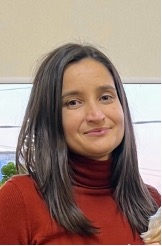Dr. Daniela Constantin

Daniela Constantin
Researcher
No. 42. Treboniu Laurean Street
Cluj-Napoca, Romania
Luminescence dating
daniela.constantin@ubbcluj.ro
Education:
PhD: Babes-Bolyai University, Environmental Science, 2015
B.S.: Babes-Bolyai University, Environmental Science, 2010
Research:
Current research is focused on assessing the maximum achievable precision of luminescence
ages of sedimentary quartz. High-resolution luminescence chronologies are constructed for
sedimentary deposits that archive the paleoclimatic changes during the Quaternary. The
problem resides in the incorporation of luminescence ages in age-depth-models which is limited
to this date due to the complexity of the uncertainty estimation system involved in age
evaluation which is not fully standardized yet. This problem is approached by conducting a
thorough empirical assessment in error limit assessment by field and laboratory studies of
coeval known age samples, and observing the degree of precision and accuracy that can be
achieved by luminescence dating. The final aim is the improvement of age modeling studies of
luminescence-dated paleoclimate archives, especially loess deposits and an informed and
correct incorporation of luminescence ages into age-depth models, thus increasing their
robustness and accuracy.
Selected Publications:
1. Constantin, D., Mason, J.A.,Veres, D., Hambach, U., Panaiotu, C., Avram, A., Groza, S.M.,
Tecsa, V., R. Begy, Zhoul., Marković, S., Gerasimenko, N., Timar-Gabor, A. 2021. OSL-dating
of the Pleistocene-Holocene climatic transition in loess from China, Europe and North
America, and evidence for accretionary pedogenesis. Earth-Science Reviews, 221, 103769.
2. Avram, A., Constantin, D., Veres, D., Kelemen, S., Obreht, I., Hambach, U., Marković, S.B.,
Timar-Gabor, A., 2020. Testing polymineral post-IR IRSL and quartz SAR-OSL protocols on
Middle to Late Pleistocene loess at Batajnica, Serbia. Boreas, 49, 615-633.
3. Constantin, D., Veres, D., Panaiotu, C., Anechitei-Deacu, V., Groza, S.M., Begy, R.C.,
Kelemen, S., Buylaert, J.P., Hambach, U., Marković, S.B., Gerasimenko, N., Timar-Gabor, A.
2019. Luminescence age constraints on the Pleistocene-Holocene transition recorded in
loess sequences across SE Europe. Quaternary Geochronology, 49, 71-77.
4. Constantin, D., Jain, M., Murray, A.S., Buylaert, J.P., Timar-Gabor, A. 2015. Quartz
luminescence response to a mixed alpha – beta field: Investigations on Romanian loess.
Radiation Measurements, 81, 110-115.
5. Constantin, D., Begy, R., Vasiliniuc, S., Panaiotu, C., Necula, C., Codrea, V., Timar-Gabor, A.
2014. High resolution OSL dating of the Costinești section Romania using fine and coarse
quartz. Quaternary International, 334-335, 20-29.
